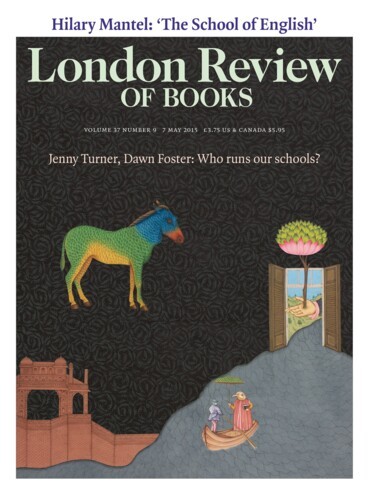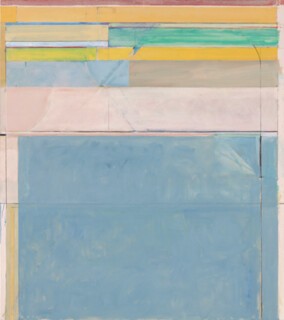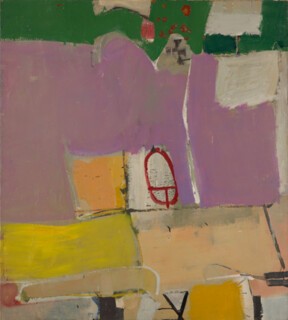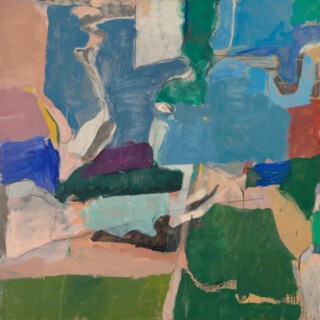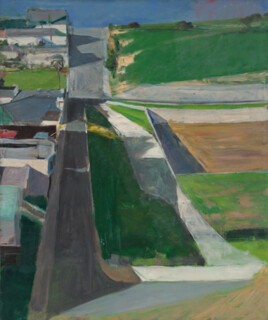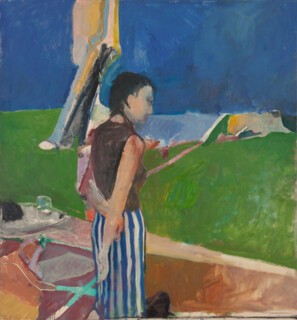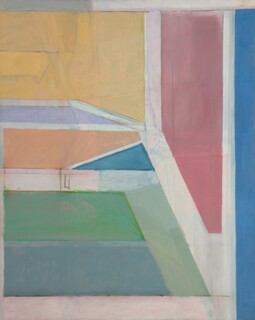Three years or so before his death, Richard Diebenkorn illustrated an elegant volume of Yeats’s poems from Arion Press in San Francisco, introduced by Helen Vendler. Vendler had already done an edition of Ashbery’s ‘Self-Portrait in a Convex Mirror’ for Arion, printed on roundel pages – wheels of paper 18” in diameter – with work by several artists, including Willem de Kooning and Jim Dine, as well as a selection of Wallace Stevens with a frontispiece by Jasper Johns; 1992 saw an edition of Kaddish, White Shroud and Black Shroud with lithograph portraits by Kitaj. Diebenkorn’s Yeats, which came out between the Stevens and the Ginsberg, contained six of the artist’s etchings, five of them touching studies of a man’s jacket on a hanger, evolving across the sequence into a sort of suit bag, and a curious coat, cut like a bomber jacket, in a patchwork of segments. The prompt in this case is obviously ‘A Coat’ (‘I made my song a coat/Covered with embroideries’), while the theme as a whole takes us to one of the last poems, ‘The Apparitions’, each stanza ending with the couplet: ‘Fifteen apparitions have I seen;/The worst a coat upon a coat-hanger.’ Both references are open-hearted and uncomplicated: you can imagine the verses pinned on the studio wall, as a memo from the artist to himself.
In New Mexico in the early 1950s, Diebenkorn was making impressive abstract paintings. He’d studied at California School of Fine Arts, and gone on to teach there. Clyfford Still, a powerful, sometimes daunting presence, was on the staff and Rothko visited: Diebenkorn remembered helping him hang a show of his work in 1947. But like Elmer Bischoff and David Park, with whom he made the turn to figurative painting a few years later, Diebenkorn was asking questions that abstract expressionism couldn’t always answer, even though, as the early works in the show at the Royal Academy (until 7 June) suggest, he was a loyal and talented disciple: the LA Times described him as ‘one of the most gifted artists in the American non-objective field’. Yet Diebenkorn, who expressed a deep admiration for Robert Motherwell and de Kooning, was clearly cautious about going the whole hog. Disintegrating Pig takes us through the motions of abstract painting but it’s more a rehearsal of abstraction than the thing itself and it’s difficult not to see the reconfigured ‘apparition’ of a domesticated animal. One of Diebenkorn’s children said that he discouraged them from playing spot-the-likeness with his pieces, but he agreed that if you stood on your head and looked at Disintegrating Pig you’d probably end up somewhere in the farmyard.
The problem persists in a lower key in other works of the period, including pictures made in 1953, while Diebenkorn was teaching in Illinois: the Urbana series, like the Albuquerque paintings, often gives the viewer the illusion of looking down at a distant landscape, as though from the harness of a parachute, rather than across at the matter on the canvas. To know that Diebenkorn worked in the mapping department during the war is to sense once again that we’re in the realm of depiction, which – once you’re up for the rigorous abstraction that Clement Greenberg championed when the two men met in New York – is largely a case of borrowing, or quotation, from the world beyond the work. In Urbana aerial views over field and copse are what’s on loan; before that it was a pig; later a coat upon a coat-hanger.
None of this gets in the way of the earlier work unless we decide that Diebenkorn has fallen short by comparison with the great abstract painters of his day. The palette is dusty – tans, sandy browns, cloudy ochres. The best pictures record a deep satisfaction with a narrow range of colours (mostly analogous), and maybe, as the catalogue suggests, with the landscape of New Mexico. But then, abruptly, we find ourselves in front of Albuquerque #7, where no sense of locality can account for such a confident set of colour decisions, including a fabulous stand-off between dark red and pale grey green, mediated by a short, horizontal swatch of orange. (We’ll glimpse this orange again five years later on the back of a chair in Woman by the Ocean.)
With Diebenkorn’s move to Berkeley, the illusion that we’re looking down at the canvas is broken by the presence of shapes we can envisage both from above and in elevation. The big questions – how far to abstract, and whether or not the viewer is meant to naturalise (‘river’, ‘promontory’, ‘meadow’) – are addressed obliquely by putting greater emphasis on gesture and process and working in more lavish colours. Then, with the turn to figurative oil painting, around 1955 or 1956, those questions are laid to rest. Or so it seems. At the heart of the Bay Area Figurative movement – which detained Diebenkorn for about ten years – there was probably a growing reservation about ‘American-type’ painting and its New World hubris. Diebenkorn often said how much he owed to European painting and the debt is acknowledged here, in the second room of the show, in big works depicting human figures framed in landscape – on a terrace, at a window – or secluded in shady interiors, in placid unanimity with their surroundings, sunken-eyed, reading, or lost in contemplation. The effect is unsettling, and doesn’t feel as ‘European’ as the still lifes or the seated nude (gouache on paper) from the mid-1960s. Two landscapes, bare of figures, suggest an easy, American-colloquial interest in grand, open spaces, but in Cityscape #1, a tapestry record of human management, with fields and buildings beside a long road, the absence of persons and the pristine brightness of the day give off a charge of anxiety.
The last room celebrates Diebenkorn’s return to abstract painting. We’ve understood by now that his career was not a single, mechanical oscillation from abstract through figurative and back, but a long argument with himself, and others, about different ways to make a good painting. The grandiose Ocean Park canvases seem to cut that conversation short with a monumental flourish. They’re hung to drive home the point: standing at the entranceway you have a sense of cool, early morning coastal light, as you pick out louvred bands of colour and big squares a bit like cotton blinds: pale blues, greens and yellows, adorned with a livery of fine lines, mostly in a lower key. You move in, the bands flatten, and your next impression is of large, translucent openings in the gallery walls, like stained glass windows (all that’s missing are the pews); the paint is weightless. As you square up to the best of the bigger pieces – #79 and #116 are the ones to look for – you’re plunged into the final moments of a quest narrative with a happy ending, in which Diebenkorn discovers his version of the true grail in Ocean Park, Santa Monica, and American abstract painting takes another bow. It’s a good story, even though a few years after the last of these lovely pictures, the artist was off with his etching needle to try his hand at coats.
Send Letters To:
The Editor
London Review of Books,
28 Little Russell Street
London, WC1A 2HN
letters@lrb.co.uk
Please include name, address, and a telephone number.
